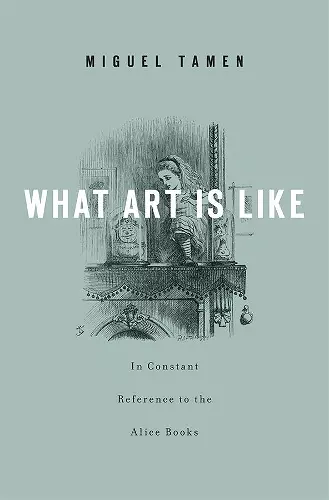What Art Is Like, In Constant Reference to the Alice Books
Format:Hardback
Publisher:Harvard University Press
Published:29th Nov '12
Currently unavailable, and unfortunately no date known when it will be back

Miguel Tamen's What Art Is Like admirably opens up both the risks and rewards of stepping through the looking glass. No reader of this book will come out unscathed: it is both the most rigorous application of 'Alice-logic' and the most idiosyncratic work of 'Alice-philosophy' ever to have been attempted. It is also, in parts, extremely funny. -- Peter de Bolla, author of Art Matters Miguel Tamen's wonderful book-compact, highly original, lucid, and utterly attractive in style and tone-is most impressive for the care, depth and acuity with which it discerns, articulates, and scrutinizes both leading and misleading analogies that exert explicit or implicit influence on our thinking about art and aesthetic experience. If, as Tamen shows in What Art Is Like, we place art next to other experiences that can profoundly change us and then work through the telling similarities and differences, we come to see a good deal about what kind of thing art actually is for us. An engaging book, sparkling with life, brilliantly preserving a special lightness of touch while acutely investigating some matters of deep human concern. -- Garry Hagberg, author of Describing Ourselves: Wittgenstein and Autobiographical Consciousness
This comic, serious inquiry into the nature of art takes its technical vocabulary from Alice’s Adventures in Wonderland and Through the Looking-Glass. It is ridiculous to think of poems, paintings, or films as distinct from other things in the world, including people. Talking about art should be contiguous with talking about other relevant matters.
What Art Is Like is a comic, serious inquiry into the nature of art. It provides welcome relief from prevailing modes of explaining art that involve definitions, philosophical claims, and critical judgments put forth by third parties. Scrapping all such chatter, Miguel Tamen’s aphoristic lark with aesthetic questions proceeds by taking its technical vocabulary only from Lewis Carroll’s Alice’s Adventures in Wonderland and Through the Looking-Glass.
According to Tamen, it would be ridiculous to think of poems or paintings or films or any variety of artistic production as distinct from other things in the world, including people. Talking about art should be contiguous with talking about many other relevant and important matters. Tamen offers a series of analogies and similes to help us imagine these connected experiences. One, taken from the analytical table of contents where the book is writ small, suggests that “understanding a poem is like understanding a cat; neither ever says anything back and you can’t keep a conversation with them. All art is like this, but not only art is like this; nature, the past, numbers are also like this.”
Tamen takes up many central issues in aesthetics and the philosophy of art, including the connection between art and having fuzzy ideas about art, the mistake of imagining that art-decisions are put forth by art-courts where you are both judge and jury, and the notion that what happens with art also happens to you.
Miguel Tamen's What Art Is Like admirably opens up both the risks and rewards of stepping through the looking glass. No reader of this book will come out unscathed: it is both the most rigorous application of 'Alice-logic' and the most idiosyncratic work of 'Alice-philosophy' ever to have been attempted. It is also, in parts, extremely funny. -- Peter de Bolla, author of Art Matters
Miguel Tamen's wonderful book—compact, highly original, lucid, and utterly attractive in style and tone—is most impressive for the care, depth and acuity with which it discerns, articulates, and scrutinizes both leading and misleading analogies that exert explicit or implicit influence on our thinking about art and aesthetic experience. If, as Tamen shows in What Art Is Like, we place art next to other experiences that can profoundly change us and then work through the telling similarities and differences, we come to see a good deal about what kind of thing art actually is for us. An engaging book, sparkling with life, brilliantly preserving a special lightness of touch while acutely investigating some matters of deep human concern. -- Garry Hagberg, author of Describing Ourselves: Wittgenstein and Autobiographical Consciousness
ISBN: 9780674067066
Dimensions: unknown
Weight: unknown
128 pages